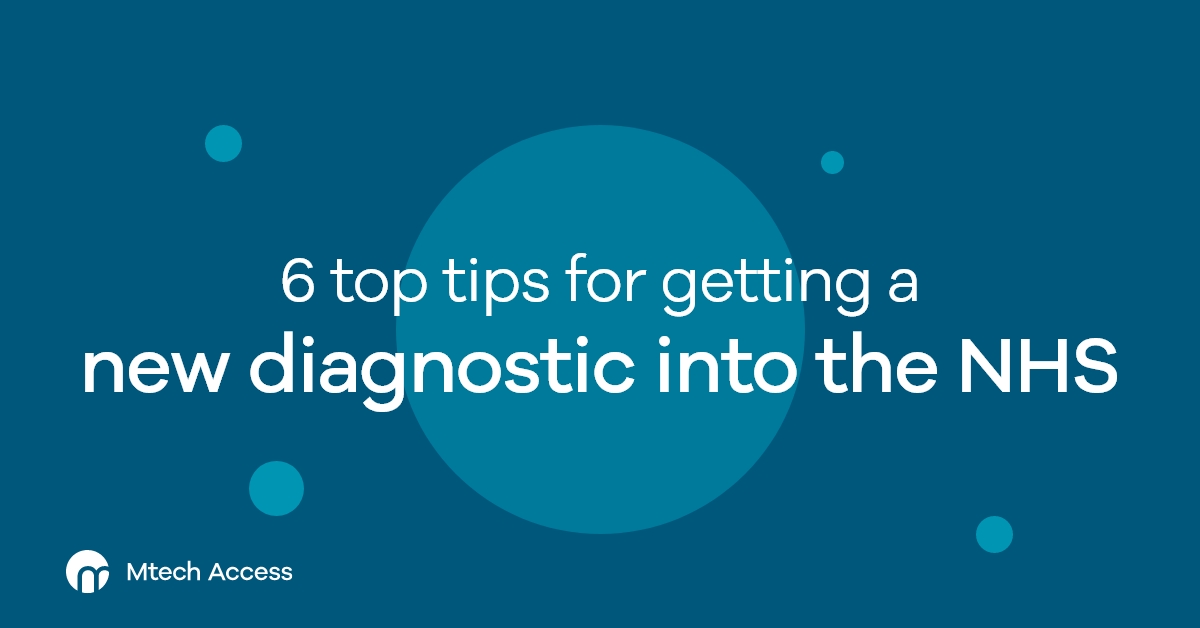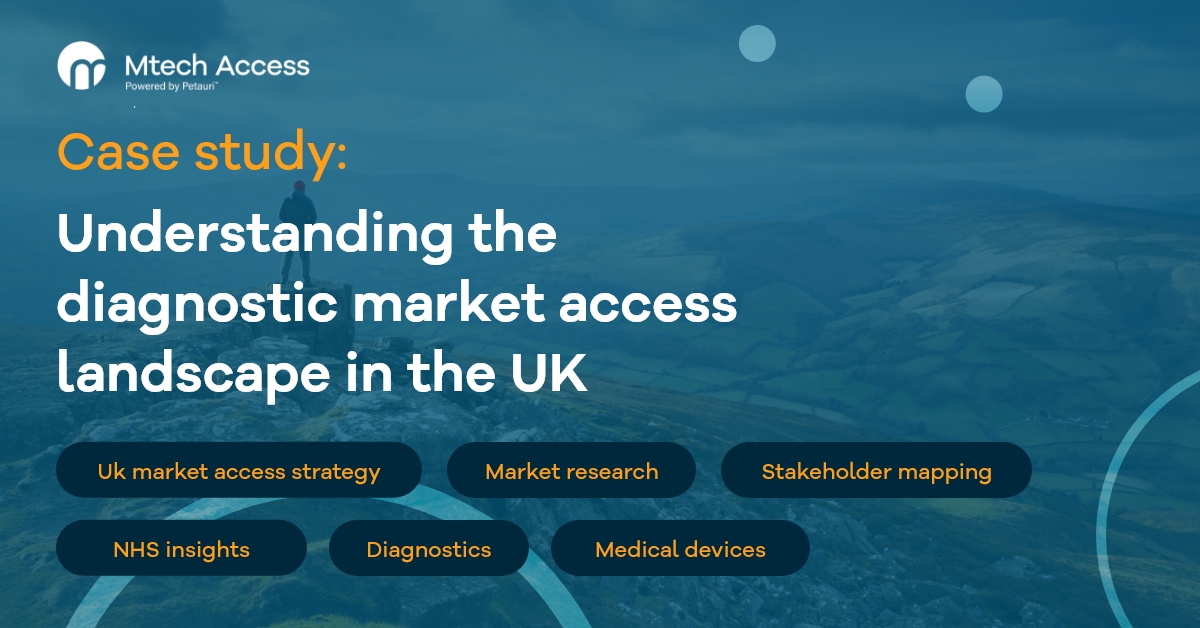
The evolving UK market access landscape for emerging diagnostic technologies
In recent times we have seen a change in how diagnostic technologies are perceived by UK NHS payers and decision makers. A number of forces have combined to make diagnostics a key part of the solution to some of the pressures facing the NHS.
The pandemic made at-home and in-community diagnostics part of our everyday lives. Diagnostics are a vital part of the prevention agenda and will play a key role in population health management. And we have seen an increase in community models, such as diagnostic hubs.
NHS leaders recognise that new diagnostic technologies could help to reduce increased demand and pressures on the healthcare system. Indeed, the NHS Long Term Plan makes a commitment to accelerate the uptake of selected innovative diagnostic technologies.
Yet, achieving market access in the competitive and complex UK landscape is never easy. In this article, our UK market access specialists pull together some of the common challenges faced by market access and commercialisation leaders when bringing a new diagnostic to the NHS, and make recommendations for overcoming some of these hurdles.
Key UK market access challenges faced by diagnostics companies
Understanding the dynamic nature of the NHS
It can be a challenge for those outside of the NHS to keep up with the evolving environment and the challenges facing leaders in order to understand their perspectives. Different areas of the NHS are likely to vary in their level of preparedness for innovative diagnostic technologies.
Staying up to date on policy, procedure and regulation
Keeping afoot of the policy, technology assessment, standard operating procedures, and regulatory landscapes is key in order to understand how to align value messages and communication strategy with policy, regulator and other assessors’ needs.
Finding the diagnostic’s place in the pathway
We have found that it is much easier to make the case for your diagnostic, and demonstrate its true value to the healthcare system, if you can demonstrate where and how the diagnostic will slot in to support and enhance the existing pathway of care. This only works when the pathway outlined is accurate and resonates with the decision maker. As a result, understanding local and system pathways and service provisions becomes a key challenge.
Understanding funding provisions
A key hurdle for any new technology is finding funding. There are several evidence generation and funding pathways available within the UK for diagnostics (and other medical technologies), including:
- Digital Technology Assessment Criteria (DTAC)
- Artificial Intelligence in Health and Care Award
- NHS Innovator Accelerator
- NICE’s Evidence Standards Framework for Digital Health Technologies
- NHS Payment Scheme
- Medical Technologies Evaluation Programme
- NHS Accelerated Access Collaborative: Medtech Funding Mandate*
Funding provisions with the NHS are in flux and evolving as the NHS introduces Integrated Care Systems (ICSs) and Integrated Care Boards (ICBs) and their new local structures.
*The MedTech Funding Mandate policy team have decided not to add any additional technologies to the programme for 2023/24, instead opting to focus on accelerating adoption for those they are already supporting. However, the NHS Accelerated Access Collaborative has just launched the ‘Health Technology Navigation Pathway Tool’ to support innovators. This offers some really helpful guidance for both innovators and larger companies looking to navigate the access pathways into the NHS, so is well worth a look!
Identifying key stakeholders
In the NHS, time is limited, and so it is important to identify the right people to speak to, first time. A key challenge to market access is identifying those responsible for planning, commissioning and delivering services in diagnostics, and then understanding their roles and responsibilities within the healthcare and pathology system.
Scaling up
A great way to get a new diagnostic technology into the NHS is via a small, short-term pilot with a local Primary Care Network (PCN) or through your local Academic Health Science Network (AHSN). The hurdles to access here can be lower and it can enable you to prove the concept and generate real-world evidence to support your preposition. After a company completes a pilot, however, there is a risk that the local care system moves on or that it remains an entirely local phenomenon. Scaling up from a small, short-term pilot to a long-term place, system and ultimately nation-wide footprint can be a real challenge. When exploring system and national routes to market access, it is important to present the value demonstrated in the pilot in a way that showcases the impact the diagnostic could have at this system/national level.
6 top tips to overcome these common market access challenges for diagnostics launching in the NHS
1) Engage with NHS experts
Continually check-in and engage with NHS and best practice experts to understand the landscape and identify and optimise opportunities. At Mtech Access, we have a network of 100+ Associates from across the NHS, who hold strategic, operational and clinical leadership roles. Their knowledge, expertise and insights help us and our clients stay one step ahead.
2) Stay up to date with policy, funding and regulation
Ensure you stay up to date with new policy and the evolving funding and regulatory landscape in the NHS, and understand any changes so that you can identify the right decision makers, understand the funding flows and pathways, and craft a communication strategy that resonates.
Many of our clients opt to receive regular updates from our experts on the policy, funding and regulatory changes of relevance to their products and disease areas.
3) Develop a solution-focused value proposition
Develop strong value propositions that offer solutions to the key challenges facing the NHS, such as reducing diagnostic backlogs, emergency admissions and hospitalisations.
In this video-clip from our NHS Whispers webinar series, Stephen Slough (Chief Digital Information Officer, NHS Dorset) explains the importance of presenting a proposition that is relevant to the decision-maker, demonstrates an awareness of their situation and challenges, and presents them with solutions.
4) Build a Case for Change
Building a Case for Change is key to scaling up and moving beyond a pilot study to ensure your technology is not only embedded in local pathways, but is also taken forward at a national level. Throughout the pilot, be sure to support your key stakeholders in the NHS with data collection. Use these data to build a Case for Change, develop case studies, build business case templates, and help your NHS customers secure continued funding.
Our experts in evidence synthesis, health economics and market access can help you identify the evidence you need, evaluate it and present it in a way that builds a Case for Change.
5) Map out the care pathway
Map local pathways to understand service provision and identify opportunities where your technology could be used across an integrated system approach, e.g. across primary, secondary, and community care.
Our UK market access experts work with our network of NHS Associates to map out care pathways, both nationally and locally, whilst identifying opportunities and avenues you may not have otherwise explored.
6) Identify and understand key stakeholders
Conduct stakeholder mapping to understand the roles, responsibilities, objectives and challenges of those within the healthcare system able to bring your diagnostic into the care pathway. Be sure to look at those with responsibility for planning, commissioning, implementing and assessing services.
In collaboration with our NHS Associates, we can provide you with accurate hierarchies and role profiles for the stakeholders of most relevance to your access strategy.
Developing your diagnostic market access strategy
If you’re looking for strategic or tactical support to get your diagnostic (or other Medtech innovation) into to the NHS, email info@mtechaccess.co.uk today.
This case study describes our work with a diagnostics company who were looking to understand the market landscape for their diagnostic, get up to date on relevant regulatory policy and identify key stakeholders. We produced a report to inform both their local field teams and global executives.



